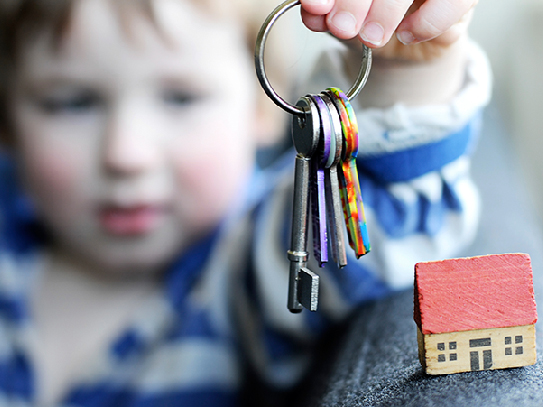
Permanency and Stability in Out of Home Care

We recently had the opportunity to submit to the Victorian Enquiry into the Implementation of the Children, Youth and Families Amendments (Permanent Care and Other Matters) ACT 2014 (Permanency Amendment Inquiry). In the submission, we highlighted our experience working with children placed in Out of Home Care in Victoria, as well as our strongly held belief that permanence promotes stability.
We thought we’d share an excerpt of our submission with you in today’s blog entry. You can download the full submission here, written by Noel MacNamara, National Manager, Research and Policy at the Australian Childhood Foundation.
The Experience of ACF in working with children placed in Out of Home Care in Victoria
 It is the experience of ACF that many children are left for too long in unsafe and traumatising circumstances. Whilst this lack of safety is not the intention of professionals involved, it is often the result of delayed decision making or an apparent focus on the rights of biological parents at the expense of their children. The children who we see and whose entry to care is delayed by indecision or drift regularly experience:
It is the experience of ACF that many children are left for too long in unsafe and traumatising circumstances. Whilst this lack of safety is not the intention of professionals involved, it is often the result of delayed decision making or an apparent focus on the rights of biological parents at the expense of their children. The children who we see and whose entry to care is delayed by indecision or drift regularly experience:
- a longer exposure to pre-care adversity
- higher emotional and behavioural problems
- subsequent placement disruption and instability
Our experience and view is supported by research. A longitudinal study (Bromfield et al. 2007) of a random sample of 100 Australian cases of child abuse notifications found that 65 per cent of the children had experienced chronic maltreatment. Many repeat notifications were treated in isolation, and interventions tended to focus on parents, rather than children. That study indicated that the impact of chronic maltreatment on children’s health and wellbeing was unlikely to be assessed.
Longer, repeated and chronic exposure to these relationships and environments has significant risks for these children. Current neurophysiological research has detailed the mechanisms through which stress responses are activated in children and young people who experience abuse related trauma (Southwick, Rasmussen, Barron and Arnseten, 2005, Gunnar and Quevedo, 2007). As Schore (2002) has noted
“…the stress literature clearly shows acute stress produces short-term and reversible deficits, while repeated, prolonged, chronic stress is associated with long-term patterns of autonomic reactivity, expressed in “neuronal structural changes, involving atrophy that might lead to permanent damage, including neuronal loss…(p.11)”.
Other Australian research studies support international findings that children and young people who have suffered abuse and neglect are at risk of more chronic and complex health difficulties compared with the general Australian population. Webster (2016) has constructed a table of the impacts of children in Australian OOHC:
|
Table 1: Health issues in samples of children in Australian OOHC research studies 2005-2015 HEALTH ISSUE FREQUENCY RANGE REFERENCES |
||
|
Immunisations not up-to-date |
15% – 53% |
Arora, Kaltner & Williams 2014 Raman & Sahu 2014 Kaltner & Rissel 2011 Kaltner & Rissel 2010 Nathanson & Tzioumi 2007 |
|
Immunisations not up-to-date |
15% – 53% |
Arora, Kaltner & Williams 2014 Raman & Sahu 2014 Kaltner & Rissel 2011 Kaltner & Rissel 2010 Nathanson & Tzioumi 2007 |
|
Vision difficulties |
18% – 33% |
Arora, Kaltner & Williams 2014 Raman & Sahu 2014 Kaltner & Rissel 2011 Chambers et al. 2010 Kaltner & Rissel 2010 |
|
Hearing difficulties |
10% – 28% |
Arora, Kaltner & Williams 2014 Raman & Sahu 2014 Kaltner & Rissel 2011 Chambers et al 2010 Kaltner & Rissel 2010 |
|
Growth abnormalities/ nutrition deficits |
14% – 18% |
Raman & Sahu 2014 Nathanson & Tzioumi 2007 |
|
Eating disorders/ overweight/ obesity |
24%-63% |
# Cox et al. 2014 Tarren-Sweeney 2006 |
|
Expressive or receptive language delay or referral to speech pathology |
11% -69% |
Arora, Kaltner & Williams 2014 Raman & Sahu 2014 Kaltner & Rissel 2011 Chambers et al. 2010 |
|
Clinically significant emotional/behavioural difficulties |
48%-62% |
# Jackson et al. 2009, # Milburn et al. 2008, Sawyer et al. 2007, Tarren-Sweeney & Hazell 2006 |
|
Learning/education difficulties |
9% -60% |
Arora, Kaltner & Williams 2014 |
|
Psychotropic medication used for behavioural management |
16% |
Tarren-Sweeney 2010 |
|
Child required two or more referrals for further health assessment and/or treatment |
70% |
Kaltner & Rissel 2011 Kalter & Rissel 2010 Nathanson et al. 2009 |
|
Hepatitis screening required |
8%-14% |
Arora, Kaltner & Williams 2014 Nathanson & Tzioumi 2007 |
|
Mental health difficulties |
15% – 62% |
Arora, Kaltner & Williams 2014 Kaltner & Rissel 2011 Tarren-Sweeney 2010 # Frederico, Jackson & Black 2008 # Milburn et al. 2008 Sawyer et al. 2007 Tarren-Sweeney & Hazell 2006 |
|
Referral for formal developmental assessment required |
5% |
Arora, Kaltner & Williams 2014 |
|
Ongoing monitoring of growth and development concerns by paediatrician required |
30% -41% |
Arora, Kaltner & Williams 2014 Raman & Sahu 2014 Kaltner & Rissel 2011 |
|
Dental problems |
26% |
Raman & Sahu 2014 |
# denotes references which describe research findings relating to samples of children in OOHC in Victoria
Maguire et al. (2015) conducted a systematic review of international academic literature over a 65 year period to 2012 and concluded that:
…children experiencing neglect or emotional abuse exhibit far-reaching impacts on their behavioural, emotional, cognitive and social development. The cascading effect of maladaptive externalising and internalising behaviours, impaired emotional regulation, delayed numeracy, literacy and language development can manifest in difficult interpersonal relationships, low school attainment and negative feelings of anxiety and depression.
Children and young people form a view of themselves and of others by how their primary carers treat them. If those that are meant to protect us hurt us emotionally, physically or sexually, our view of our own worth and the trustworthiness of others is likely to be compromised.
Children who have suffered traumatic experiences often struggle to negotiate appropriate relationships with adults and their peers. Common patterns include:
- Struggles with boundaries; they may be overly friendly with strangers; they may have limited awareness of other’s personal space.
- Distrust and suspiciousness of others.
- Difficulties maintaining friendships due to aloofness or excessive ‘neediness’.
- Difficulty reading or attuning to other’s emotional states.
- View of themselves as unlovable or fundamentally ‘bad’.
Traumatised children find it difficult to make ‘meaning’ out of their experiences. They have few or no effective internal maps to guide their actions. As a result, they react rather than respond. Their beliefs about themselves are determined by the very people who violate them. They can find it difficult to see adults as supportive. Their brains are so over-activated that they are able to take in very little new information easily. In particular, their memory systems continue to remain under stress. They fail to consolidate new learning. Their working memory for even the easiest set of instructions can be severely compromised. Traumatised children experience the present with little reference to their past, even though their behaviour, feelings and state are affected by their experiences of violation. They do not have access to the qualities that make them who they are. They have a transient sense of their own identity. Their sense of future is without plans or a sense of possibility.
Children and young people suffer these traumatic experiences in dysfunctional relationships. It is in healthy, stable relationships that they will be helped to recover. These relationships must be privileged, promoted and supported. It is the view of ACF that all efforts should be made to keep children at the centre of decision making and that that decision making should promote stability, safety and permanence. These efforts imply a need for a fresh consideration of legislative provisions, policy and practice guidance.
Promoting Stability through Permanence
DHHS defines permanency as the achievement of an enduring care arrangement for a child that promotes the child’s safety, development, and sense of belonging. The intent is to prevent children from drifting in or between placements without early, clear and consistent decision-making for their future.
 It is ACF’s opinion that an OOHC system that promotes stability, resilience and healthy psychological development for children and young people, should be based around an early or decisive entry to care (where appropriate), stable and high-quality placements that provide good parenting and are responsive to the child’s needs, and a supported transition to independent adulthood.
It is ACF’s opinion that an OOHC system that promotes stability, resilience and healthy psychological development for children and young people, should be based around an early or decisive entry to care (where appropriate), stable and high-quality placements that provide good parenting and are responsive to the child’s needs, and a supported transition to independent adulthood.
To develop into a psychologically healthy human being, a child must have a relationship with an adult who is nurturing, protective, and fosters trust and security. Attachment refers to this relationship between 2 people and forms the basis for long-term relationships or bonds with other persons (Ainsworth, 1973; Bowlby, 1969). Attachment is an active process. Attachment to a caregiver is essential to the development of emotional security and social conscience. Tilbury & Osmond (2006) argue that:
“The importance of continuity and stability in the care arrangements and other relationships, particularly in the early years of childhood, is well founded in scientific knowledge on the brain development of children. Research has unequivocally identified that uncertainty, instability and disruption can have harmful effects on a child’s wellbeing and development”.
Optimal child development occurs when a spectrum of needs are consistently met over an extended period. Successful parenting is based on a healthy, respectful, and long-lasting relationship with the child. This process of parenting, especially in the psychological rather than the biologic sense, leads a child to perceive a given adult as his or her “parent.” That perception is essential for the child’s development of self-esteem and self-worth. A child develops attachments and recognises as parents adults who provide day-to-day attention to his needs for physical care, nourishment, comfort, affection, and stimulation. This is not based on a biological link to the child.
Stable placements allow for the development of stable and strong relationships. It is through these new, positive relationships that children will learn to trust and to develop strong and positive attachments. Developing secure attachment has long been associated with positive child development. As Monck and colleagues identify:
“The early development of secure attachment with primary carers is the foundation of the child’s ability to optimise what he or she can subsequently gain from new experiences and relationships”
(Monck et al, 2003; p.19).
There are clear implications for action in terms of knowledge development and resource. All professionals working with vulnerable children in the Out of Home Care system require a sound working knowledge of the requirements for optimal child development, in the context of trauma and abuse. The service system itself must be built upon a legislative framework that supports this development and affords opportunities for healing and recovery. Finally, a suite of placement alternatives that were appropriately resourced would ensure that children could be matched to the right care environment at the right time.
It is ACF’s opinion that Victoria must not return to a system that privileges the needs and timeframes of adults at the cost of the developmental needs of children. The previous legislation and policies left children and those who care for them in a state of uncertainty for many years. ACF has worked with many children where it has taken up to five years to reach a final order. We believe this is systems abuse at its most destructive.
What are your thoughts around striking the right balance for children in Out of Home Care?
